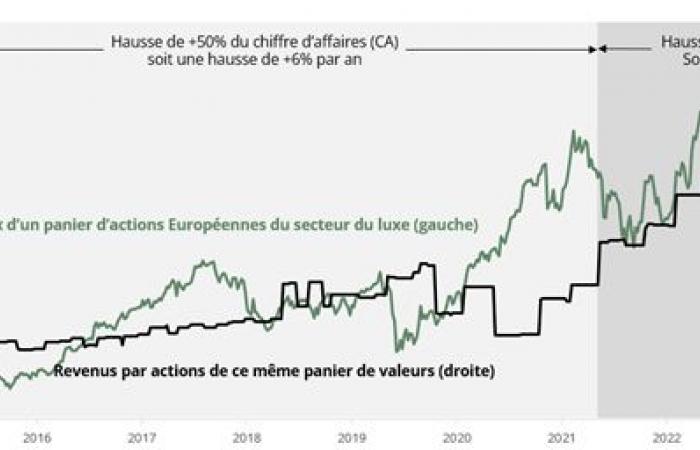After two years of fantastic growth, the top of the range has been grimacing in recent months.
Growth in turnover in the luxury sector is decelerating and is expected to stagnate until the end of the year. Stock prices in the sector have come down from their all-time highs.
This “normalization” scared some investors who wavered with the decline of overly optimistic expectations. (bear market slide down a slope of hope).
Optimism of a resurgence of the Chinese consumer has dimmed. Likewise, the hope of seeing the income of luxury companies grow at a rate three times higher than GDP to eternal life – rather than at a (completely enviable) measure of twice economic growth – is fading. If we add rising production costs, expensive digital transformations and exacerbating geopolitical tensions, we get a rather worrying picture.
Evolution of the price and income per share of a basket of European stocks in the luxury sector
Source: Carmignac, Bloomberg, Octobre 2024
But looking closer, there is no danger in the house.
The million dollar question
For investors the pace at which, if at all, sales will recover is crucial. The problem is not limited to the evolution of turnover. Margins also matter. Revenue growth of 2% or 6% will make all the difference.
In the luxury sector, fixed costs typically represent two-thirds of total costs – and they are rising: real wages are positive, raw material prices are high and, in most Western countries, leases are indexed to price. ‘inflation.
For a company like Hermès, whose sales are growing at a rate of more than 5%, a cost reduction strategy is unlikely, and therefore there is no cause for concern. On the other hand, for groups whose costs increase more quickly than income, the challenge is significant.
The season of results publications and a decisive French budget
The luxury sector is known to reduce its spending excessively at the bottom of the cycle and conversely spend excessively at the top of the cycle. We are there. Sales have reached their peak for most prestigious brands and margins are slowing everywhere.
New fear. France’s decision to increase corporate tax to “find” 60 billion euros to cover a 6% public deficit adds to the risk of disappointment when the results of certain companies in the sector. Indeed, Mr. Barnier’s finance bill for 2025 provides for a “temporary” surcharge of 10% for companies with a turnover of more than 1 billion euros and 20% for those whose turnover exceeds 1 billion euros. The business is more than 3 billion euros. And as Milton Friedman said, “nothing is more lasting than a temporary government program”…
We estimate that these measures will reduce the earnings per share of luxury groups based in France by 2% for next year. Not to mention the (negative) impact of additional income tax (the Exceptional Contribution on High Incomes) on the wealth effect of those who are most inclined to buy luxury products.
At LVMH – considered the benchmark in the sector – third quarter turnover is expected to increase by +2.5%, thanks to leather goods and perfumes & cosmetics (mainly in the United States) and improvement – although still negative – in the trajectory of wines and spirits. At first glance, this seems decent. But we remain cautious. The pace of slowdown is likely to be greater than anticipated and investments have been high (partnership with Formula 1, the Olympic Games, fashion shows between seven and eight figures) even though turnover is at higher. The specter of cost reduction could resurface.
At Kering and Burberry, which are in a relatively similar situation, the double-digit contraction in revenues leads to cost reductions that could be massive. And, with them, the fear of seeing them weigh more on the (already negative) growth prospects of the bottom of the class.
On the other hand, L’Oréal, of which 40% of turnover comes from the luxury division, appears less affected; the share of variable costs (50% of total costs) is higher there than elsewhere. If the group’s turnover is unlikely to remain at current high levels and therefore lead to a decline in profit growth. The latter should fall from 7.9% to 5% and remain entirely consistent with the historical growth multiples of the French cosmetics group.
Finally, Hermès should see its turnover increase by +10% everywhere except Asia (excluding Japan) and France; the leather goods and ready-to-wear divisions are doing well. Unlike some of its peers, price increases there are more rhythmic and have therefore not alienated buyers.
From bogeyman to benefactor
In the short term, the challenges facing certain luxury groups are more frightening than encouraging, but the longer-term outlook is rather positive.
The start of a global cycle of lowering monetary policy rates and the latest Chinese stimulus announcements put a floor on the downside risk.
For investors willing and able to see beyond the “wall of worry,” 2025 should be an exciting year for the sector.
First of all, offshore demand revived by the renewed confidence of the Chinese middle class following fiscal and financial recovery plans (China represents 25% of demand in the sector). Second, the improvement in the economic trajectory in the United States and Europe. Third, the sector benefits from low sales elasticity to price increases.
In the absence of a “painful landing” in the global economy, 2025 should see sector sales moving in the right direction. Thus a trajectory from “slowdown on the way to normalization” to that of “resumption towards a more normal pace” should allow the sector to experience a more favorable fate.







